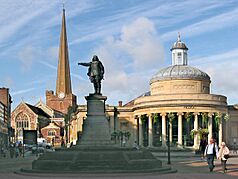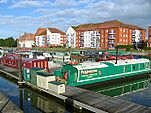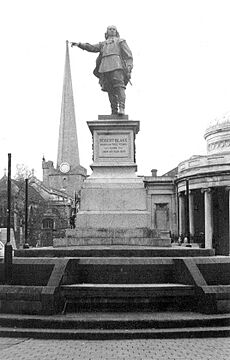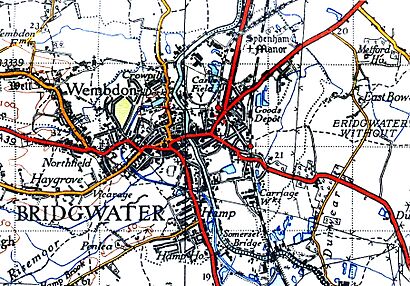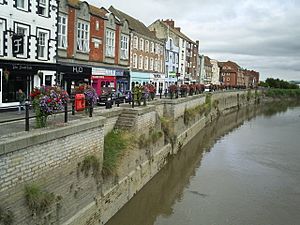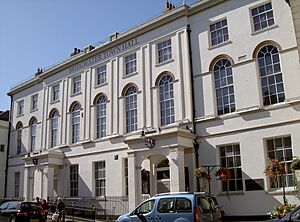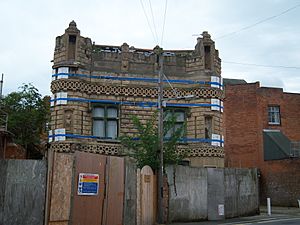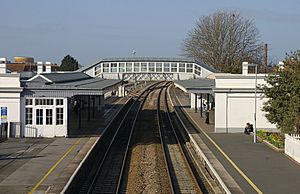Bridgwater facts for kids
Quick facts for kids Bridgwater |
|
|---|---|
|
From the top to bottom-right, Corn Exchange, Church of St Mary and statue of Robert Blake, Bridgwater War Memorial, The Port, Somerset Brick and Tile Museum, Bridgwater Town Hall
|
|
| Population | 41,276 |
| OS grid reference | ST305370 |
| Civil parish |
|
| Unitary authority |
|
| Ceremonial county | |
| Region | |
| Country | England |
| Sovereign state | United Kingdom |
| Post town | BRIDGWATER |
| Postcode district | TA5, TA6, TA7 |
| Dialling code | 01278 |
| Police | Avon and Somerset |
| Fire | Devon and Somerset |
| Ambulance | South Western |
| EU Parliament | South West England |
| UK Parliament |
|
| Councillors |
|
Bridgwater is a historic market town and civil parish in Somerset, England. In 2021, about 41,276 people lived there. Bridgwater is located at the edge of the Somerset Levels, which is a flat, well-wooded area. The town sits on both sides of the River Parrett. It has been a major port and trading hub since the time of the Industrial Revolution. Many of its old factories and businesses are still there today. A canal, the M5 motorway, and the GWR railway line connect Bridgwater to its larger neighbour, Taunton.
Historically, the town was known for its strong opinions and protests. The Battle of Sedgemoor, where the Monmouth Rebellion was finally defeated in 1685, happened nearby. Important buildings include the Church of St Mary and the Blake Museum. The museum is a restored house on Blake Street, where Admiral Blake was born in 1598. Bridgwater also has an arts centre and hosts the yearly Bridgwater Guy Fawkes Carnival.
Contents
What's in a Name?
It's believed that Bridgwater was first called Brigg, which means quay (a place where boats load and unload). Some think the name might come from an old English word for "gang plank" or an old Norse word for "quay." In the Domesday Book (a survey from 1086), the town was called Brugie. After the Norman invasion, the land was given to Walter of Douai. So, the town became known as Burgh-Walter, Brugg-Walter, and Brigg-Walter, which eventually changed to Bridgwater. Another idea is that it means "Bridge of Walter."
A Look Back in Time
Bridgwater's Story
Bridgwater is mentioned in the Domesday Book and even earlier in the Anglo-Saxon Chronicle from around 800 AD. It became a trade centre because it was located at the mouth of Somerset's main river. In a famous story, Alfred the Great supposedly burned some cakes while hiding near Bridgwater after a Danish invasion in 875.
William Briwere, a powerful person, was given control of Bridgwater by King John in 1201. William Briwere helped King John grant three important documents in 1200. These allowed the building of Bridgwater Castle, the creation of a borough (a town with special rights), and a market. Bridgwater Castle was a large stone building covering about 8 or 9 acres. It had a moat (a ditch filled with water) up to 65 feet wide. The castle also had a keep (main tower), a dungeon, a chapel, and stables. It was built on the only high ground in town and controlled the main bridge. Today, you can still see a 12-foot-thick part of the castle wall and a water gate on West Quay. William Briwere also started St John's hospital and began building the town's first stone bridge. He also founded the Franciscan Bridgwater Friary (a religious house).
During the 13th century, Bridgwater was held by powerful lords who fought against King Henry III. In 1381, local farmers in Bridgwater took part in the Peasants' Revolt. They attacked Sydenham House, killed tax collectors, and destroyed records.
Bridgwater received special permissions from King Edward IV in 1468, which were confirmed many times later. The town sent representatives to Parliament from 1295 until 1870. Bridgwater used to have many markets and fairs for selling wool, wine, and cloth. These became less important after medieval times. However, the port's shipping trade grew again after a new dock was built in 1841. For centuries, corn and timber have been imported.
The Gunpowder Plotter Guy Fawkes is remembered during the carnival season in Bridgwater. This includes a big parade with lights, ending in "Squibbing," where large fireworks are fired at the same time. Bridgwater was very supportive of the Protestant faith at the time of the plot, so they celebrated stopping the conspiracy with great excitement.
During the English Civil War, the town and castle were held by the King's supporters, known as Royalists. The castle was later destroyed on purpose in 1646. In 1651, King Charles II was helped to flee to France after a battle.
In the 1685 Monmouth Rebellion, Duke of Monmouth was declared King in Bridgwater. He led his troops in a night attack, but they were defeated at the Battle of Sedgemoor. The Duke was later executed, and nine local people were put to death for treason.
The Chandos Glass Cone was built in 1725 to make glass. Later, it was used to make pottery, bricks, and tiles until 1939. A small part of the cone, about 2.4 meters tall, has been saved as an ancient monument.
Bridgwater was the first town in Britain to ask the government to ban slavery in 1785.
In 1896, workers in Bridgwater's brick and tile factories went on strike. The government sent soldiers to the town to remove barriers by force after reading the Riot Act (a law that allowed authorities to break up large gatherings).
In World War II, the Bridgwater and Taunton Canal was part of the Taunton Stop Line, a defence to stop a German invasion. You can still see small concrete bunkers (pillboxes) along the canal. The first bombs fell on Bridgwater on August 24, 1940, destroying homes and killing seven people. Later, a prisoner of war camp was set up for Italian prisoners. Before the invasion of Europe, American troops were stationed in the town.
After the war, many council estates (homes built by the local government) were constructed, especially in the 1950s.
On November 4, 2011, West Quay and 19 nearby buildings were emptied because a 40-meter section of a wall collapsed after heavy rain. The old hospital, built in 1813, closed in 2014 and was replaced by a new community hospital.
Bridgwater's Port History
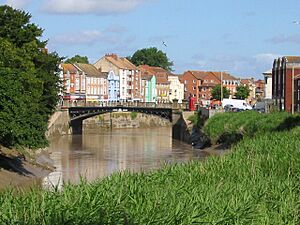
In the Middle Ages, the River Parrett was used to transport stone from Ham Hill. Bridgwater became its own port in 1348, covering about 80 kilometres of the Somerset coastline.
Historically, Bridgwater was the main port on the river. The first bridge was built here in 1200. Quays (platforms for loading ships) were built in 1424. A Customs House was located on West Quay, and there was a dry dock (for repairing ships) and boat yards on East Quay. Large ships could sail up the river to Bridgwater Town Bridge. Goods could then be moved to smaller boats to go further inland to Langport and Ilchester. After 1827, goods could also be sent to Taunton via the Bridgwater and Taunton Canal. A special floating harbour was built between 1837 and 1841, and the canal was extended to it. The harbour area had flour mills, timber yards, and shops for ship supplies.
Shipping in Bridgwater grew a lot after the Bridgwater Docks were built. It was busiest between 1880 and 1885, with about 3,600 ships entering the port each year. Bridgwater also built about 167 ships, with the last one, the Irene, launched in 1907.

Dunball wharf was built in 1844 by coal merchants. It used to be connected to the railway. Today, ships no longer dock in Bridgwater town itself. However, in 2006, over 90,000 tonnes of cargo were handled in the port authority's area, mostly stone products through the wharf at Dunball. The wharf is now used for bringing in stone, sand, and gravel from the Bristol Channel.
How Bridgwater is Run
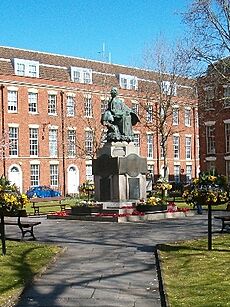
Bridgwater used to be a special "Borough" (a type of town government). But in 1972, it became part of the Sedgemoor district.
Bridgwater Town Council was created in 2003 and is based at Bridgwater Town Hall. It has 16 elected members who look after things like parks, bus stops, cemeteries, street lighting, and war memorials.
All other local services are handled by Somerset Council, which started on April 1, 2023.
Bridgwater is part of the Bridgwater and West Somerset area, which elects one person to the House of Commons (part of the UK Parliament). The current MP is Ian Liddell-Grainger.
In 2018, Diogo Rodrigues became the first person from Portugal to be elected as a Mayor in England. He was also Bridgwater's youngest mayor ever.
Town Friends Around the World
Bridgwater is "twinned" with these towns and cities, meaning they have special friendly relationships:
- Uherské Hradiště, Czech Republic (since 1992)
- La Ciotat, France (since 1957)
- Homberg, Efze, Germany (since 1992)
- Marsa, Malta (since 2006)
- Priverno, Italy (since 2015)
- Camacha, Madeira Autonomous Region, Portugal (since 2019)
Bridgwater's Landscape
Bridgwater is built on a small hill of marl (a type of soil) in a flat area with lots of alluvial deposits (soil left by rivers). It's on the edge of the Somerset Levels. To the north are the Mendip hills and to the west are the Quantock hills. The town sits on both sides of the River Parrett, about 10 kilometres from where it flows into the Bridgwater Bay National Nature Reserve. This area has large mud flats, saltmarshes, and sandy areas. It's a very important wetland for wildlife.
Weather in Bridgwater
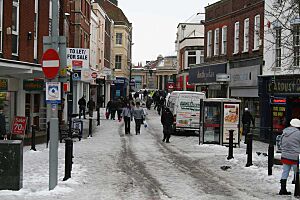
Like the rest of South West England, Bridgwater has a mild climate that is generally wetter than other parts of the UK. The average yearly temperature is about 10°C. Temperatures don't change as much between seasons as in other places because of the nearby sea. July and August are the warmest months, with average high temperatures around 21°C. In winter, average low temperatures are around 1°C or 2°C. Most rain in the south-west comes from Atlantic storms. The average rainfall is about 700 millimetres per year. It typically snows for 8–15 days. Winds are strongest from November to March and lightest from June to August. The wind usually blows from the south-west. Yeovilton
Population Facts
In 2001, Bridgwater had a population of 35,800 people. This was a big increase from 3,634 people in 1801.
| Population since 1801 - Source: A Vision of Britain through Time & ONS, 2006 Population projections; 2001 census | |||||||||||||||
| Year | 1801 | 1851 | 1901 | 1911 | 1921 | 1931 | 1941 | 1951 | 1961 | 1971 | 1981 | 1991 | 2001 | 2008 | 2011* |
|---|---|---|---|---|---|---|---|---|---|---|---|---|---|---|---|
| Population Sedgemoor | 27,205 | 48,575 | 49,907 | 51,263 | 52,082 | 52,917 | 57,964 | 63,497 | 71,684 | 80,933 | 88,544 | 99,317 | 105,867 | 113,500 | 117,300 |
Bridgwater's Economy
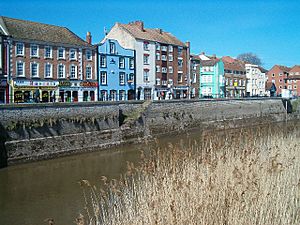
As early as 1300, Bridgwater's port sent wheat, peas, and beans to Ireland, France, and Spain. By 1400, it was also exporting cloth. By 1500, it was the biggest port in Somerset and later the fifth largest in England, until Bristol became more important in the 1700s. In its busiest times, Bridgwater imported wine, grain, fish, coal, and timber. It exported wheat, wool, cloth, cement, bricks, and tiles. Unlike Bristol, Bridgwater was never involved in the slave trade. In fact, in 1785, it was the first town in Britain to ask the government to ban slavery.
The Bridgwater ship Emanuel was one of three ships that helped Martin Frobisher search for the Northwest Passage in 1577.
Bridgwater's Industries
Bridgwater was a top industrial town in Somerset and is still a major manufacturing centre. In the 1800s, it was a big producer of clay tiles and bricks, including the famous "Bath brick". These were sent out through the port. In the 1890s, there were 16 brick and tile companies, and 24 million bricks were exported each year. You can learn about these industries at the Somerset Brick and Tile Museum on East Quay.
These industries declined after World War II because they didn't use new machines. The "Bath Brick" became less important when new cleaning products were invented.
During the 1800s, Bridgwater also had several iron factories. George Hennet's Bridgwater Iron Works made bridges, railways, and machines for famous engineers like Brunel. This location was good because raw materials could come by boat from Wales, and finished products could be sent to south Devon by railway.
At the start of World War II, the government built a factory near Bridgwater to make explosives. This factory, called ROF Bridgwater, closed in 2008.
British Cellophane Ltd opened a large factory in Bridgwater in 1937, making cellophane. During World War II, the factory made Bailey bridges for the invasion of Europe. The cellophane factory closed in 2005, which was a big loss for the town. At one time, it employed about 3,000 people. However, new businesses have started up on the Express Park business area, including Gerber Juice and Toolstation.
Today, Bridgwater is still an important industrial centre in Somerset. Industries include making plastics, engine parts, industrial chemicals, and food. Being close to the M5 motorway and between Bristol and Exeter, Bridgwater also has two large distribution centres. Argos has a regional distribution centre here. A new £100 million farming business centre opened in 2007.
A large commercial development called Gravity is planned for the old ROF Bridgwater site. It will focus on low-carbon economy businesses.
Cool Places to See
Bridgwater is home to the Somerset Brick and Tile Museum, built on part of an old brick and tile factory. Castle House was built in 1851 and was one of the first homes in the UK to use a lot of concrete. It shows a new way of using concrete to look like traditional stone.
The Bridgwater Town Mill, which dates back to the Middle Ages, is at the end of Blake Street. There are plans to make it part of the Blake Museum.
A restored house on Blake Street is believed to be where Robert Blake was born in 1598. It is now the Blake Museum and has exhibits about his life and local history. His statue from 1898 now faces down Cornhill. The public library was built in 1905.
Sydenham House was a large estate built in the early 1500s. Its owners were on the losing side in the English Civil War and the Monmouth Rebellion. It is now on the grounds of the former British Cellophane factory. In 2012, EDF bought the site. The old industrial buildings were removed in 2015. The site is planned to be temporary housing for workers building the Hinkley Point C nuclear power station.
Getting Around
As trade grew during the Industrial Revolution, Bridgwater was connected to Taunton by the Bridgwater and Taunton Canal in 1827. As trade increased, docks were built in the town, connected to an extension of the canal, both opening in 1841. On June 14, 1841, the Bristol & Exeter Railway opened from Bristol to Bridgwater. The railway also opened a workshop in town for coaches and wagons. Bridgwater railway station, designed by famous engineer Brunel, is now a special historic building.
The importance of shipping and the docks started to decline after 1886. This was because the Severn Tunnel opened, causing fewer coal imports by sea. The situation got worse as railways expanded, and ships became too big for the port. The docks were last used for commercial purposes in 1971. Although they now have a marina, they are not used much. The areas around the quays have been developed for housing.
The Drove Bridge is the newest road bridge over the river. It was built in 1992 and allows boats to pass underneath. Upstream from this is the Telescopic Bridge, built in 1871. It used to carry a railway track over the river to the docks and could move sideways to let boats through. It was last opened in 1953. The moving part was removed in 1974, but people protested, so the rest of the bridge was saved as a Scheduled Ancient Monument. It was later used as a road crossing until a new road bridge was built next to it. Now, only pedestrians use it.
The next bridge is the Town Bridge. There has been a bridge here since the 1200s. The current cast iron bridge was finished in 1883. It replaced an earlier bridge from 1797, which was the first cast iron bridge in Somerset. In March 1958, a new concrete road bridge, the Blake Bridge, opened to take traffic away from the town centre. It now carries the A38 and A39 roads. On the southern edge of Bridgwater, a bridge carries the railway over the River Parrett. Brunel designed a brick bridge in 1838, which was replaced by a steel bridge in 1904. Slightly further east is a modern concrete bridge that carries the M5 motorway over the river and railway. It opened in 1973.
Bridgwater also has a bus service to and from London twice a day.
Learning in Bridgwater
Bridgwater has many primary and infant schools, such as Eastover Community Primary School and St Mary's Primary School. Secondary schools include Robert Blake Science College, Brymore Academy, Chilton Trinity School, Bridgwater College Academy, and Haygrove School. There are also special schools for students with specific needs.
Bridgwater was chosen for a government plan called "Building Schools for the Future" (BSF), which aimed to rebuild and improve secondary schools. This plan was supposed to redevelop all four secondary schools and two special schools in Bridgwater. However, in 2010, some parts of the BSF program in Bridgwater were cancelled or reviewed.
Further education (learning after secondary school) is offered by Bridgwater and Taunton College. In 2018, a new centre for the National College for Nuclear opened at the Bridgwater campus. It helps train workers for the Hinkley Point C nuclear power station.
Places of Worship
The main church is the Church of St Mary. It has parts from the 1300s and a tall, slender spire. It has been changed a lot over time but has a beautiful painted screen behind the altar. It is a very important historic building.
There is also Christ Church Unitarian Chapel on Dampiet Street, built in 1688. It still has many original features. It is also a very important historic building.
Other churches include the Church of St John the Baptist and Elim Pentecostal Church. There is a Salvation Army building and St Joseph's Roman Catholic church.
Classes in Buddhism and meditation used to be held in the Quaker Meeting House. In 2014, this building was bought by local Muslims and became the Bridgwater Islamic Centre.
Arts and Culture
When you drive near Bridgwater on the M5 motorway, you can see the Willow Man sculpture. It's a tall human figure made from willow branches, sometimes called the Angel of the South. It stands 12 meters tall and was created by sculptor Serena de la Hey. It's the largest known sculpture made of willow, which is a traditional local material.
Bridgwater is home to Music on the Quantocks, a successful music series that features world-class classical music, poetry, jazz, and folk. Events are held in churches, barns, and halls around Bridgwater.
The Bridgwater Arts Centre opened on October 10, 1946. It was the first community arts centre in the UK to get money from the new Arts Council of England. It is in a beautiful historic building on Castle Street, which was designed by Benjamin Holloway. Holloway also designed the Lions building on West Quay around 1730.
Somerset Film opened their community media centre, The Engine Room, in 2003. It lets people use computers and equipment for free on certain days to learn how to edit videos, design websites, or watch films.
Castle Street was used as a filming location in the 1963 movie Tom Jones. The horror writer and film journalist Kim Newman went to school in Bridgwater and set his 1999 novel Life's Lottery in a made-up version of the town called Sedgwater.
In 2013, a community radio station called Access FM started on 104.2 FM. It was the first truly local radio station for the town in a while. It focused on programming for young people aged 16-25. Access FM was the first station to broadcast live from the Bridgwater Guy Fawkes Carnival in 2014.
In 2015, Access FM changed its name and became Sedgemoor FM, which launched on April 4, 2016. Sedgemoor FM broadcasts on 104.2FM across Bridgwater and the district. It provides local news, events, and job openings.
Yearly Events
Bridgwater is most famous for the illuminated "Bridgwater Guy Fawkes Carnival". About 150,000 people from all over the country and even other countries come to see it. It's held every year on the Saturday after the first Friday of November (the closest Saturday to November 5). The carnival has over 100 entries, many of which are huge vehicles called "Carnival carts." These carts can be up to 100 feet long and are covered with dancers or scenes and up to 22,000 lightbulbs! The parade follows a 2.5-mile route and lasts 2 to 3 hours. Later in the evening, there's "squibbing," where large fireworks are fired at the same time in the street outside the town hall.
Bridgwater Fair usually takes place in September. It starts on the last Wednesday of September and lasts four days. The fair is held on St Matthew's Field, also known as the Fair Field. Today, it's a funfair, the second largest in England after the Nottingham Goose Fair. It started in 1249 as a horse and cattle fair, lasting eight days around St Matthew's day (September 21).
In the first weekend of July, the yearly "Somerfest" arts festival is held in Bridgwater. This event includes lots of rock, jazz, and classical music, dance, drama, and visual arts with both national and local artists.
A new yearly event started in 2014: the Bridgwater Science Festival. It takes place in May and brings science-related fun and activities to the town hall.
An annual Food and Drink Festival also happens each year at the Bridgwater Town Hall. It takes place in early March and shows off the best local food with cooking demonstrations from local chefs.
News and Media
Local news and TV shows come from BBC West and ITV West Country. Bridgwater's local radio stations are BBC Radio Somerset, Heart West, Greatest Hits Radio South West, and Sedgemoor FM. Local newspapers include the Somerset County Gazette, SomersetLive, and Bridgwater Mercury.
Sports and Fun
Sports
Bridgwater United F.C. is a football (soccer) club based at Fairfax Park. The club started in 1898.
Bridgwater & Albion is Somerset's top rugby team. It was founded in 1875.
The cricket club plays at The Parks on Durleigh Road.
Bridgwater Hockey Club started in 1925 and has several men's and women's teams.
Leisure
East Bridgwater Sports Centre has badminton courts, outdoor football pitches, squash courts, and a fitness room.
Bridgwater had swimming pools from 1890 until 2009. The Bridgwater Lido opened in 1960 but was taken down in the late 1980s to make way for a supermarket. An indoor pool called Sedgemoor Splash opened in 1991 but closed in 2009 and was also removed for a supermarket. A new pool is planned as part of the rebuilding of Chilton Trinity School.
The town is on the route of two walking trails: the Samaritans Way South West and the River Parrett Trail.
Famous People from Bridgwater
- Admiral Robert Blake (1598–1657) was born in Bridgwater. His home is now the Blake Museum.
- John Chubb (1746–1818), a local merchant and artist, painted portraits and scenes of Bridgwater. His work is at the Blake Museum.
- John Clark (1785–1853) created the first machine that could automatically generate text in 1845.
- Donald Crowhurst (1932–1969), who tried to fake a solo yacht trip around the world, had his business in Bridgwater and was a town councillor.
- William Diaper (1685–1717), a clergyman and poet, was born in Bridgwater.
- Sir Paul Dukes (1889–1967) was born in Bridgwater and became a secret agent.
- Peter Haggett (born 1933), a geography professor, went to school in Bridgwater.
- Chris Harris (1942–2014), an English actor and writer, starred in Into the Labyrinth.
- Harry "Breaker" Morant (1864–1902), a soldier in the Boer War, was born in Bridgwater.
- Henry Phillpotts (1778–1869), who became a Bishop, was born in Bridgwater.
- John de Ponz (around 1248-1307), a royal administrator and judge in Ireland, was born in Bridgwater.
- Jean Rees (1914–2004), an artist, helped start the Bridgwater Arts Centre.
- Alexander Scoles (1844–1920), a Roman Catholic priest and architect, designed and built St Joseph's church in Bridgwater.
- James Sully (1842–1923), a psychologist, was born in Bridgwater.
- Fanny Talbot (1824–1917), born in Bridgwater, was a kind person who gave the first property to the National Trust.
Sports Stars
- Robert Dibble (1882–1963), an England rugby player, was born in Bridgwater.
- Charles Kent (1953–2005), an England rugby player, was born in Bridgwater.
- David Luckes (born 1969), an England and Great Britain hockey player, grew up in Bridgwater.
- Richard (born 1981) and Simon Mantell (born 1984), brothers and field hockey players for England, were both born in Bridgwater.
- Tommy Woods (1883–1955), an England rugby player, was born in Bridgwater.
See also
 In Spanish: Bridgwater para niños
In Spanish: Bridgwater para niños


